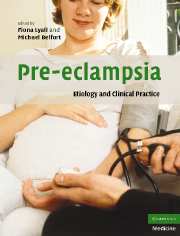Book contents
- Frontmatter
- Contents
- List of contributors
- Preface
- Part I Basic science
- 1 Trophoblast invasion in pre-eclampsia and other pregnancy disorders
- 2 Development of the utero-placental circulation: purported mechanisms for cytotrophoblast invasion in normal pregnancy and pre-eclampsia
- 3 In vitro models for studying pre-eclampsia
- 4 Endothelial factors
- 5 The renin–angiotensin system in pre-eclampsia
- 6 Immunological factors and placentation: implications for pre-eclampsia
- 7 Immunological factors and placentation: implications for pre-eclampsia
- 8 The role of oxidative stress in pre-eclampsia
- 9 Placental hypoxia, hyperoxia and ischemia–reperfusion injury in pre-eclampsia
- 10 Tenney–Parker changes and apoptotic versus necrotic shedding of trophoblast in normal pregnancy and pre-eclampsia
- 11 Dyslipidemia and pre-eclampsia
- 12 Pre-eclampsia a two-stage disorder: what is the linkage? Are there directed fetal/placental signals?
- 13 High altitude and pre-eclampsia
- 14 The use of mouse models to explore fetal–maternal interactions underlying pre-eclampsia
- 15 Prediction of pre-eclampsia
- 16 Long-term implications of pre-eclampsia for maternal health
- Part II Clinical Practice
- Subject index
- References
16 - Long-term implications of pre-eclampsia for maternal health
from Part I - Basic science
Published online by Cambridge University Press: 03 September 2009
- Frontmatter
- Contents
- List of contributors
- Preface
- Part I Basic science
- 1 Trophoblast invasion in pre-eclampsia and other pregnancy disorders
- 2 Development of the utero-placental circulation: purported mechanisms for cytotrophoblast invasion in normal pregnancy and pre-eclampsia
- 3 In vitro models for studying pre-eclampsia
- 4 Endothelial factors
- 5 The renin–angiotensin system in pre-eclampsia
- 6 Immunological factors and placentation: implications for pre-eclampsia
- 7 Immunological factors and placentation: implications for pre-eclampsia
- 8 The role of oxidative stress in pre-eclampsia
- 9 Placental hypoxia, hyperoxia and ischemia–reperfusion injury in pre-eclampsia
- 10 Tenney–Parker changes and apoptotic versus necrotic shedding of trophoblast in normal pregnancy and pre-eclampsia
- 11 Dyslipidemia and pre-eclampsia
- 12 Pre-eclampsia a two-stage disorder: what is the linkage? Are there directed fetal/placental signals?
- 13 High altitude and pre-eclampsia
- 14 The use of mouse models to explore fetal–maternal interactions underlying pre-eclampsia
- 15 Prediction of pre-eclampsia
- 16 Long-term implications of pre-eclampsia for maternal health
- Part II Clinical Practice
- Subject index
- References
Summary
Introduction
The immediate clinical consequences and associations of pre-eclampsia are the subject of intense study and are reviewed in depth throughout this volume. It is natural for any woman who experiences a hypertensive disorder in pregnancy to enquire what implications this has, if any, for her future health. While the long-term outcome of women who experience pre-eclampsia has been the subject of research, there are still major uncertainties regarding this area due to the inherent problems of long-term longitudinal clinical studies. The aim of this chapter is to summarize the recent evidence regarding the implications of pre-eclampsia occurring during pregnancy for a woman's health in later life. Moreover, methodological issues related to addressing this research question will also be reviewed both to assist interpretation of the existing literature and to provide guidance for how future studies might be conducted.
Methodological issues in determining long-term associations with pre-eclampsia
Study design
Epidemiological studies generally aim to quantify the association between developing a given disease and some characteristic in a population. The characteristic can take many forms, such as a blood test, environmental exposure or socio-economic factor. The first step in any study is to determine whether the outcome and exposure are associated to a degree which is greater than expected by chance. Any analysis assumes that a sufficient number of individuals were studied to allow detection of an association, were any to exist. Having demonstrated an association, the next step is to determine whether the association is likely to be causal.
- Type
- Chapter
- Information
- Pre-eclampsiaEtiology and Clinical Practice, pp. 232 - 240Publisher: Cambridge University PressPrint publication year: 2007



